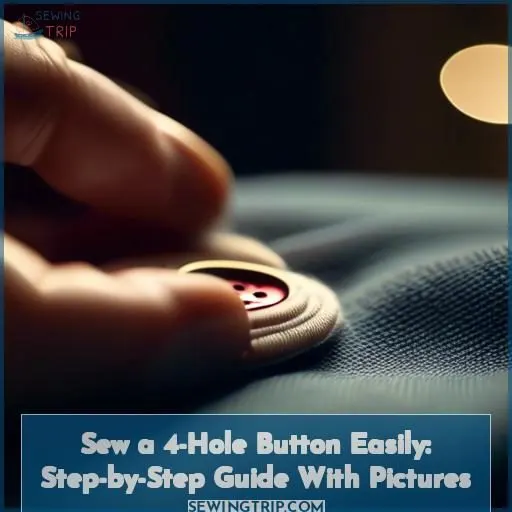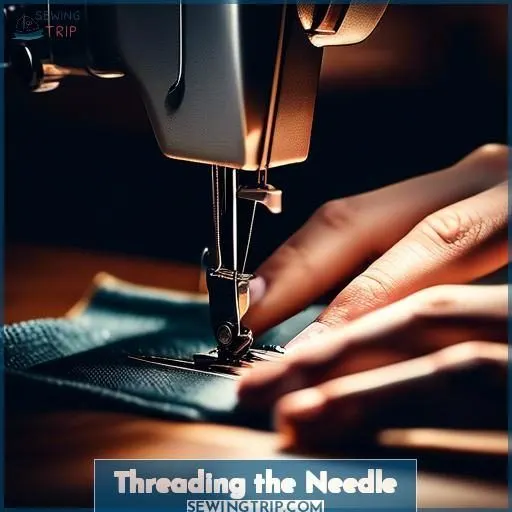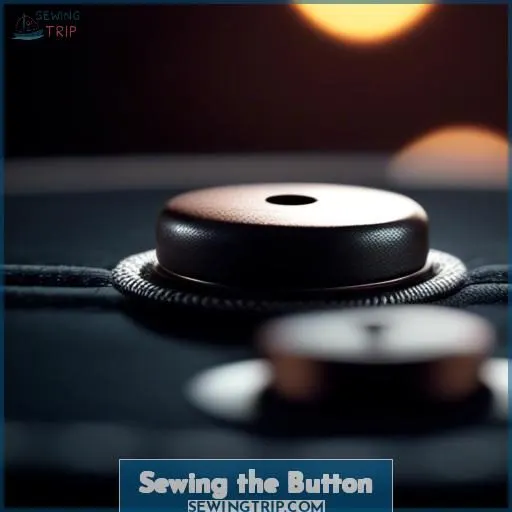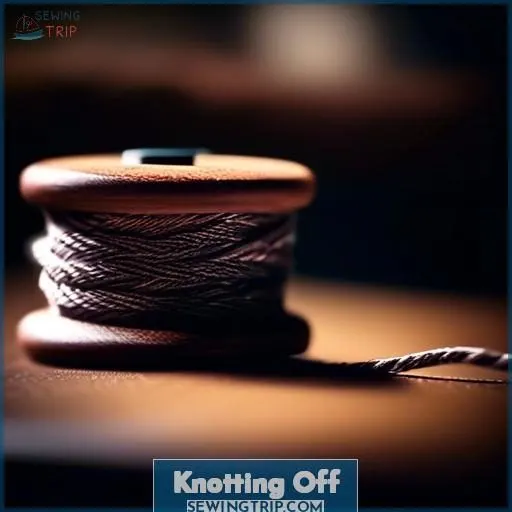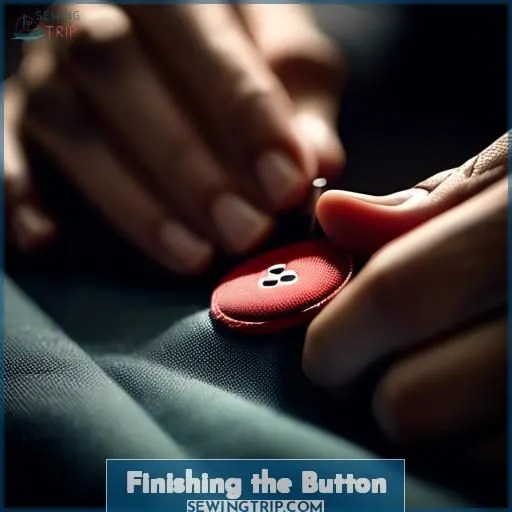This site is supported by our readers. We may earn a commission, at no cost to you, if you purchase through links.
To sew on a 4-hole button, start by threading a needle and securing the thread. Push the needle up through the fabric from the underside, then down through one of the button holes. Repeat this process, going up and down through the holes in a parallel or crisscross pattern.
Once all holes are sewn, tie off the thread with a few knots. To finish, bring the needle up through the fabric one last time without going through the button, then pass it under the stitches to create a shank. This gives the button room to move.
Table Of Contents
Key Takeaways
- To sew a 4-hole button, use either a parallel or crisscross pattern to ensure the button is attached securely, and create a shank by wrapping the thread around the base of the button for added space and movement.
- Selecting the right materials is crucial; choose a button color that matches your fabric, a thread type and needle size appropriate for the fabric’s weight and thickness, and ensure the needle is sharp.
- Threading the needle correctly is important for a smooth sewing process; use a needle threader if necessary, choose a thread color that complements the fabric, and tie a secure knot at the end of the thread.
- After sewing the button using the chosen pattern, finish by knotting off the thread securely and trimming any excess to prevent unraveling, ensuring the button is fastened tightly and the stitches are reinforced.
How to Sew on a Button With 4 Holes?
To sew on a button with four holes, follow these steps:
- Secure the thread and bring the needle to the surface at the position of the button, then bring it through the button from the back.
- Take the needle down through the other hole and through the fabric, leaving a small gap between the button and the fabric.
- Repeat the process, working through all four holes, either to form a cross or parallel bars.
- Take the needle around the threads between the fabric and the button to form a shank.
- On the wrong side, make a couple of stitches through the threads to secure.
Remember to thread your needle, tie a knot at one end, mark the button placement position, place the button on the fabric, and sew back and forth across the button until it’s firmly fastened. After sewing, secure the thread by cutting it with scissors and tying a knot on the fabric’s back.
Materials Needed
To sew a 4-hole button, you’ll need a few essential materials. First, choose a button color that matches or complements your fabric. Next, select a thread type that’s appropriate for your project.
A needle size between 8 and 10 is usually suitable for most fabrics. Make sure your chosen needle is sharp and in good condition. The fabric suitability is important; if it’s delicate or thick, adjust your needle accordingly.
Button placement is also important; place the button where you want it before you start sewing. Gather your thread, needle, button, scissors, and any additional materials needed for your project.
Threading the Needle
To thread the needle, select a needle type that aligns with your project’s needs, such as a tapestry needle for sturdier threads or a sewing machine needle for finer threads. Choose a thread color that harmonizes with your fabric and a thread size that complements the fabric’s weight.
If you’re encountering difficulties threading the needle, utilize a needle threader or thimble to direct the thread through the eye of the needle. Securely tie a knot in the thread to guarantee its strength, and consider using a needle threader or thimble to assist you in tying the knot.
Remember to use an appropriate thread length for your project and always keep an extra thread nearby for unexpected situations.
Sewing the Button
To sew a 4-hole button, you’ll need to follow a specific pattern. The most common pattern is the parallel pattern, which involves bringing the needle back down through the opposite buttonhole, then repeating for the remaining two holes. Another pattern is the crossover pattern, where you bring the needle diagonally across the button to the next hole, then back down through the opposite hole. This creates an X pattern.
When sewing the button, it’s important to indicate where the button will be placed. Then, thread the needle and tie a knot at the end of the thread. Push the needle up through the material inside one of the holes and down through the material in the hole directly across. Repeat this process for all of the holes until the button feels secure.
For the crossover pattern, bring the needle diagonally across the button to the next hole, then back down through the opposite hole. Repeat this process to form an X pattern. For the parallel pattern, bring the needle back down through the opposite buttonhole, then repeat for the remaining two holes.
Once you’ve sewn the button, cut the thread and tie it off securely. Remember to avoid discussing things which would be discussed in the NEXT SUBTOPIC entitled ‘Knotting Off’.
Knotting Off
To guarantee the safety and durability of your button, it’s imperative to tie the thread effectively. Here’s a detailed guide on how to tie off your thread:
- Create a loop: After sewing the button, leave a long tail of thread at the starting knot. Use your fingers to create a loop in the thread, as shown in the image.
- Insert needle: Push the needle through the loop, making sure it’s on the correct side of the fabric.
- Pull tight: Pull the thread through the loop, tightening the knot.
- Repeat: Repeat steps 2 and 3 to reinforce the knot, creating a double knot for extra strength.
- Trim excess: Once the knot is secure, snip off the excess thread close to the knot.
Sewing the Second Pair of Holes
To sew the second pair of holes, insert the needle through the third hole and bring it through the fourth hole. Pull the thread through and repeat on the other side of the button.
Adjust the thread tension to make sure it’s secure.
Use a needle size that’s right for the thickness of the fabric and the alignment of the holes.
Keep the fabric tight to keep the stitches even.
Remember to keep the length and direction of the stitches the same.
Finishing the Button
To finish sewing a button, you’ll need to secure the knot and strengthen the stitches. Here’s a step-by-step guide:
- Knotting Off: Pull the thread completely through, without going through any of the holes of the fabric itself. Push the needle through the crisscrossing threads one last time, without pulling the thread all the way through. Push the needle through the loop in the thread and pull it tight, forming a knot.
- Reinforcement: For flat buttons, you can create a loop, insert the needle, pull tight to knot, and repeat to fortify the knot. If you’re using a shank button, you’ll need to hold the shank parallel to the direction of the buttonhole opening and stitch in place through the shank loop.
- Trimming the Thread: Once the knot is secure, snip the thread close to the knot.
Remember to use an appropriate needle size for your fabric and button type, and make sure that the tension is even throughout the sewing process. With these steps, you’ll have a securely attached button that will last for a long time.
Frequently Asked Questions (FAQs)
Can I use a different color thread for sewing on a button?
Using a contrasting thread color can add a stylish touch. Just make sure the thread matches the button or garment. Feel free to get creative – the possibilities are endless!
What type of needle should I use for sewing on a button?
You’ll want to use a sharp, short needle designed for sewing buttons. It’ll easily pierce the fabric and button holes without causing any damage. Feel free to experiment until you find the perfect fit!
How do I tie a knot to secure the thread when sewing on a button?
To secure the thread, simply create a loop, insert the needle through it, and pull tight. This forms a sturdy knot that’ll keep your button in place. Easy peasy!
Can I use a sewing machine to sew on a button with four holes?
Using a sewing machine for a 4-hole button? Not so fast, my friend. That’s like trying to fit a square peg in a round hole – it just won’t work. Stick to the old-fashioned hand-sewing method, and you’ll be button-tastic in no time.
How do I create a shank for a button with four holes?
To create a shank, simply wrap the thread around the button’s base a few times before securing it. This adds space between the fabric and button, allowing it to sit just right. Easy peasy!
Conclusion
With the buttons now securely in place, your garment will have a polished, professional look. Sewing a 4-hole button is a straightforward process that, once mastered, will become second nature.
Whether you’re mending a favorite item or crafting a new design, this step-by-step guide on how to sew on a 4-hole button will have you stitching with confidence.
By following these simple steps, you can effortlessly add a touch of elegance to your clothes.

